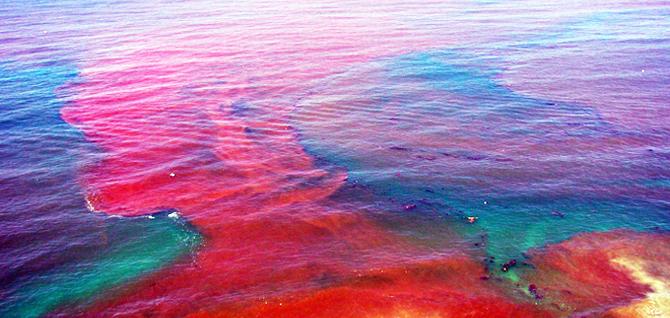Astrid Schnetzer, an associate professor in marine earth and atmospheric sciences, would occasionally see sea lions as they arrived at the Fort McArthur Mammal Care Center. Sometimes the sea lions she would see had been sprawled out along piers, exhibiting erratic behavior or completely unresponsive — all signs of domoic acid poisoning.
Domoic acid is one of several toxins some algae can produce when they accumulate in large numbers — a phenomenon often referred to as a red tide or an algal bloom. Schnetzer has spent much of her time studying Harmful Algal Blooms and is scheduled to talk about the growing concern over their increasing impact and frequency Saturday at the College of Physical and Mathematical Sciences Scope Academy.
So many algae bloom that ocean waters often become discolored between spring and early summer, when red tides are most common, and yet algae blooms remain unnoticed by the general public. However, Schnetzer thinks more people should be aware of the importance of algae and its place in the ecosystem.
“Algae are the most important primary producers in marine environments,” Schnetzer said. “They are the equivalent of grass in terrestrial systems. That’s where everything builds from and they are a vital part in that food web. If they were to go away, the web would collapse.”
It is because of this central role that algae play in the aquatic food web that many aquatic animals are affected when algae turn toxic.
“We’ve learned that there are probably at least 40 [algal] species that can produce toxins and they can have a detrimental impact because those toxins are cumulated through the food web,” Schnetzer said.
And California is not the only area in the United States that have had wildlife suffer from symptoms related to poisoning caused by these harmful algal blooms. This year, toxins that algae produce during red tides, have killed more than 240 of Florida’s 5,000 manatees, according to an article in the New York Times.
Humans can also suffer from poisoning due to these toxins when they eat seafood. According to Schnetzer, when people eat shellfish tainted by toxic algae, they can suffer from symptoms ranging from diarrhea to trouble breathing. And these problems could continue to increase due to the impact people have on coastal areas.
“A lot of these blooms have been associated with eutrophication which is a term that describes a nutrient overload in coastal waters,” Schnetzer said. “Eutrophication is an increasing problem with increasing usage of coastal areas and with sewage outflows and with industrialization … all the nutrients go into the system.”
Much of what flows into the oceans due to increased usage of coastal areas, acts as food for several algal species, which is why many species of algae have started to bloom more often, Schnetzer said.
“[Algae] can reproduce so quickly because they can just divide and they don’t need to necessarily do that sexually,” Schnetzer said. “They have a shortcut of reproducing, and that means you can have a few per liter to millions per liter within three or four days. These algae require nutrients and light and they are able to exponentially increase in numbers when both are plentiful”
Schnetzer said that finding ways to address harmful algal blooms is one reason why she was interested in studying microbial organisms such as the algae associated in red tides.
“The ultimate reason why people get into HAB research is to find a way to mitigate them and predict when they might come so you can prevent shellfish poisoning,” Schnetzer said. “[These algae] are also beautiful organisms. If you look through a microscope, they look like little jewels.”
Schnetzer is not alone at N.C. State in studying harmful algal blooms. In March, Damian Shea, a professor of biology, Donnie Hardison, a graduate in zoology and Richard Litaker, an associate professor in the department of clinical sciences, published their research on the Karenia brevis algae with William Sunda, a researcher at the National Oceanic and Atmospheric Administration.
According to a press release, the study showed that the Karenia brevis algae, can become two to seven times more toxic during phosphate limited growth. “We believe the findings will be useful to help model future toxic algal blooms and how harmful they’ll be,” Hardison said in the press release.








